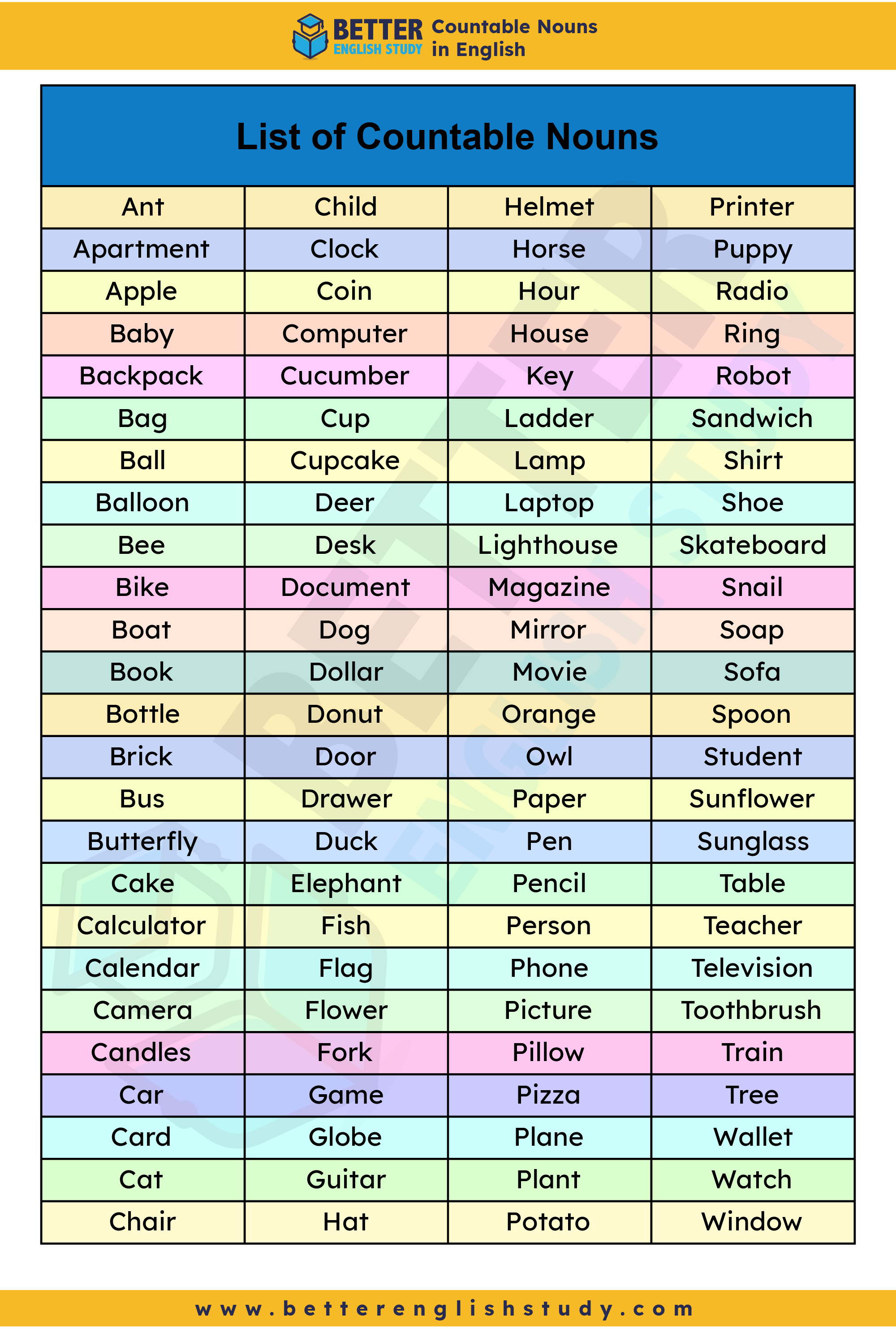
In the intricate tapestry of the English language, nouns play a crucial role in shaping our expressions and articulating the world around us. Countable nouns stand out as versatile entities that allow us to quantify and enumerate among the various classifications of nouns.
In this exploration, we’ll delve into countable nouns, understanding what they are, providing examples, and offering insights into how to identify them.
What is a Countable Noun?
At its core, a countable noun is a type of noun that can be counted. This means we can express them in singular form – a cat, a book, a friend – or in plural form – two cats, several books, many friends.
Anything that can be counted, whether a singular entity or multiple instances of that entity, falls under the umbrella of countable nouns.
A more formal definition states that a noun that can be counted in cardinal numbers (1, 2, 3, and so on) is categorized as a countable noun. This distinction is essential for understanding these nouns’ grammatical and conceptual aspects.
How to Identify Countable Nouns
Identifying countable nouns involves recognizing things that can be counted. These nouns can exist in singular and plural forms, allowing for precise quantification. Let’s explore this concept with examples.
1. Singular Form
Example: Suggest a book to read.
Explanation: The noun “book” is countable here, as we can have one or more moments.
2. Plural Form
Example: She has two dogs and three cats.
Explanation: Both “dogs” and “cats” are countable nouns, as we can count the number of individual animals.
3. Using Cardinal Numbers
Example: There are five chairs in the room.
Explanation: The noun “chairs” is countable, and we can quantify them using the cardinal number five.
4. Quantifying with Articles
Example: Can I have an apple, please?
Explanation: The noun “apple” is countable, and the use of the article “an” indicates that it can be counted as one of something.
5. Expressing Quantity
Example: We bought three new laptops for the office.
Explanation: The noun “laptops” is countable, and the quantity is expressed with the cardinal number three.
Countable nouns encompass many entities, from tangible objects like pens and chairs to living beings like dogs and friends. The key is their ability to be counted, allowing for precision and clarity in communication.
List of 100 Countable Nouns
| Ant | Child | Helmet | Printer |
| Apartment | Clock | Horse | Puppy |
| Apple | Coin | Hour | Radio |
| Baby | Computer | House | Ring |
| Backpack | Cucumber | Key | Robot |
| Bag | Cup | Ladder | Sandwich |
| Ball | Cupcake | Lamp | Shirt |
| Balloon | Deer | Laptop | Shoe |
| Bee | Desk | Lighthouse | Skateboard |
| Bike | Document | Magazine | Snail |
| Boat | Dog | Mirror | Soap |
| Book | Dollar | Movie | Sofa |
| Bottle | Donut | Orange | Spoon |
| Brick | Door | Owl | Student |
| Bus | Drawer | Paper | Sunflower |
| Butterfly | Duck | Pen | Sunglass |
| Cake | Elephant | Pencil | Table |
| Calculator | Fish | Person | Teacher |
| Calendar | Flag | Phone | Television |
| Camera | Flower | Picture | Toothbrush |
| Candles | Fork | Pillow | Train |
| Car | Game | Pizza | Tree |
| Card | Globe | Plane | Wallet |
| Cat | Guitar | Plant | Watch |
| Chair | Hat | Potato | Window |

Examples of Countable Nouns in a Sentence
- Pen: She handed me a beautiful pen.
In this sentence, “pen” is countable, representing a single writing instrument.
- Friends: We invited our new friends to the party.
“Friends” is countable here, denoting more than one individual in a social circle.
- Apples: The kids enjoyed picking red and green apples from the orchard.
In this sentence, “apples” is countable, referring to multiple individual fruits.
- Chairs: We bought four comfortable chairs for the living room.
“Chairs” is countable, indicating a specific quantity of individual pieces of furniture.
- Cats: Our neighbor has two playful cats.
In this sentence, “cats” is countable, representing two distinct animals.
- Books: She organized her collection of mystery books on the shelf.
“Books” is countable, referring to several individual literary works.
- Cars: The dealership had a display of shiny new cars.
In this context, “cars” is countable, representing multiple individual vehicles.
- Students: The teacher assigned homework to the diligent students.
“Students” is countable, referring to more than one individual attending school.
- Trees: The park is adorned with tall and leafy trees.
In this sentence, “trees” is countable, denoting multiple individual plants.
- Phones: Nowadays, people often own multiple phones for different purposes.
“Phones” is countable, indicating the presence of more than one individual communication device.
In conclusion, the world of countable nouns is an integral part of English grammar, providing us with the linguistic tools to quantify and enumerate the elements of our surroundings.
By grasping the concept of countable nouns and recognizing them in our daily interactions, we enhance our language proficiency and contribute to effective communication. So, the next time you encounter a noun that can be counted, take a moment to appreciate the nuanced role of countable nouns in shaping our linguistic expressions.
